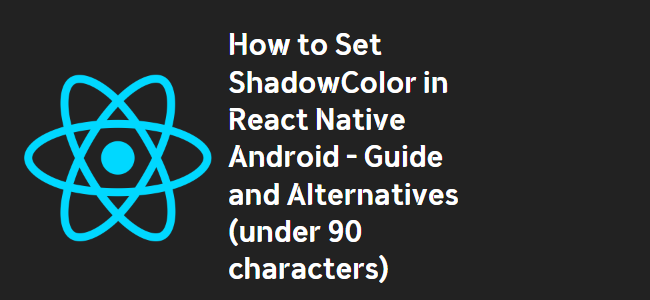
Not Able to Set ShadowColor in React Native Android
If you are working with React Native and trying to add a shadow effect to a component on Android, you may have encountered difficulties with setting the shadow color. The shadowColor attribute is not natively supported in Android, and the default gray shadow may not match your design requirements. In this article, we will explore potential solutions and workarounds to achieve a colored shadow effect on React Native Android.
Using Elevation for Shadow
As of now, the only built-in way to add a shadow effect on React Native Android is by using the elevation attribute. This attribute allows you to define the depth of the shadow effect and is supported on Android versions above 5. However, it doesn’t support customizing the shadow color directly.
const shadow = {
elevation: 8,
// Other shadow properties
};
By specifying the elevation value, you can add a default gray shadow to your component. Although it may not meet your specific requirements for a colored shadow, it is the best available option without using any external packages.
Third-Party Solutions
If you need more control over the shadow color, there are third-party libraries that can help achieve a colored shadow effect on React Native Android. One such library is react-native-shadow. This library allows you to create shadows with customizable colors, but keep in mind that it doesn’t support RGB colors at the moment.
Using LinearGradient Trick
Another workaround involves using the LinearGradient component from the react-native-linear-gradient package. By creating a gradient with a custom color, you can simulate a shadow effect on Android.
import LinearGradient from 'react-native-linear-gradient';
// Inside the render function
<LinearGradient colors={['#00000000', '#30C1DD']} style={styles.boxShadow}>
<TouchableOpacity>
<Text style={styles.text}>LOGIN</Text>
</TouchableOpacity>
</LinearGradient>
The LinearGradient component allows you to define an array of colors. In this case, the first color is transparent, creating the shadow effect, and the second color defines the actual shadow color.
Conclusion
Adding a colored shadow effect to React Native components on Android can be a challenge due to limitations in the default shadow support. However, by utilizing the elevation attribute, third-party libraries like react-native-shadow, or workarounds like the LinearGradient trick, you can achieve the desired effect. Experiment with these options to find the approach that best suits your needs and create visually appealing UIs on React Native Android.
